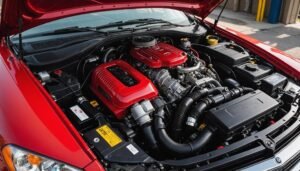Did you know that most standard cars feature only two axles, which support a total of four wheels? This common setup provides stability and efficient handling, making it ideal for everyday driving. However, not all vehicles follow this two-axle norm. As you explore further, you’ll discover how different axle configurations can impact performance, efficiency, and even your driving experience.
Key Takeaways
- Most standard passenger cars have two axles: one front axle and one rear axle.
- Each axle typically supports two wheels, providing stability and maneuverability.
- Some larger vehicles may have more axles for added load support.
- For example, heavy-duty trucks may have four axles or more to carry heavier payloads.
- The two-axle configuration is common in sedans, hatchbacks, and SUVs for efficient driving.
Understanding Axles and Their Function

Imagine driving smoothly down the road; much of that comfort stems from a fundamental component of your vehicle: the axle. This significant part connects your wheels to the car’s body, ensuring they rotate together as you drive. The axle plays an essential role in supporting the weight of the vehicle and helping to transfer power from the engine to the wheels.
When you accelerate, steer, or brake, the axle maintains stability, allowing for better handling and control. It absorbs shocks from bumps in the road, contributing to a smoother ride. Fundamentally, axles enable the wheels to spin efficiently while maintaining the integrity of the overall structure.
Understanding axles helps you appreciate their importance in vehicle performance and safety. Regular maintenance can prolong their lifespan, ensuring you enjoy that smooth ride every time you hit the road. So, next time you drive, remember the hardworking axles beneath you.
Types of Axles in Automobiles

When it comes to understanding automobiles, recognizing the types of axles can enhance your grasp of how vehicles operate. Axles play a vital role in the overall performance and functionality of your car. Here’s a quick overview of the main types of axles you’ll encounter:
| Type of Axle | Description |
|---|---|
| Front Axle | Supports the front wheels, important for steering and weight support. |
| Rear Axle | Connects the rear wheels, transfers power from the engine and supports vehicle weight. |
| Stub Axle | A short axle, used in some vehicles, mainly for support and steering. |
| Dead Axle | Doesn’t rotate with wheels; helps in weight distribution, often found in trailers. |
Understanding these axles allows you to appreciate their unique roles in vehicle dynamics and design. Each type contributes to how your car handles, steers, and performs on the road.
Two-Axle Configuration: The Standard Setup

Most cars you encounter on the road feature a two-axle configuration, which is the standard setup for many vehicles. This setup includes one axle at the front and another at the rear, providing balance and stability during your drives. Each axle typically supports two wheels, giving you the maneuverability and ease you expect from everyday cars.
With this configuration, you can enjoy better fuel efficiency, as the weight is evenly distributed, reducing strain on the engine. Additionally, two-axle cars are generally easier to handle than their multi-axle counterparts, making them ideal for city driving and parking.
When you think about buying a car, consider that the two-axle design plays a significant role in everyday functionality. This setup is the go-to choice for most compact sedans, hatchbacks, and SUVs, ensuring a smooth and comfortable ride for drivers and passengers alike.
Four-Axle Vehicles: A Look at Heavy-Duty Options
For those in need of heavier lifting capabilities, four-axle vehicles offer a substantial advantage. These heavy-duty options can support increased payloads and enhance stability, making them ideal for commercial purposes like transporting goods and construction materials.
Here’s a quick comparison of some popular four-axle vehicle types:
| Vehicle Type | Payload Capacity | Common Use |
|---|---|---|
| Delivery Trucks | Up to 26,000 lbs | Urban deliveries |
| Dump Trucks | Up to 30,000 lbs | Construction sites |
| Flatbeds | Up to 40,000 lbs | Shipping logistics |
| Tankers | Up to 30,000 lbs | Liquid transport |
| Concrete Mixers | Up to 40,000 lbs | Construction projects |
Whether you’re a business owner or a contractor, choosing the right four-axle vehicle can greatly boost your operational efficiency and capacity.
Impact of Axle Design on Performance
Axle design plays an essential role in a vehicle’s overall performance, influencing factors like stability, handling, and load capacity. When you consider axle configuration, the choice between solid axles and independent suspension can greatly affect how your vehicle responds in different conditions. Solid axles tend to offer better durability and load-bearing capabilities, making them ideal for trucks and heavy-duty vehicles. In contrast, independent setups provide improved handling and comfort, enhancing performance on smoother roads.
The material and construction of axles also impact performance. High-strength steel or aluminum alloys can lighten the weight while maintaining strength, boosting fuel efficiency and acceleration. Additionally, the axle ratio affects torque delivery; a higher ratio may give you quicker acceleration at the expense of top speed. Choosing the right axle design means balancing these elements to match your driving style and needs, ensuring peak performance for your vehicle.
All-Wheel Drive vs. Two-Wheel Drive Configurations
When comparing all-wheel drive (AWD) and two-wheel drive (2WD) configurations, it is crucial to evaluate how each setup affects traction and performance in various driving conditions. AWD systems distribute power to all four wheels simultaneously, enhancing grip on slippery or uneven terrains, which is perfect for off-roading and inclement weather. You’ll notice improved acceleration and stability, especially when cornering.
On the other hand, 2WD configurations, whether front or rear-wheel drive, typically offer better fuel efficiency and simpler mechanics. They excel on dry surfaces, making them ideal for everyday commuting. However, you may find yourself struggling in snow or mud.
Ultimately, your choice comes down to your driving needs. If you often encounter challenging conditions, AWD is a strong contender. But if you value efficiency and mainly drive on well-maintained roads, 2WD could be your best bet.
Considerations When Choosing a Vehicle Based on Axle Design
Choosing a vehicle involves more than just engine power and drive configuration; axle design plays a significant role in performance and handling. The right axle design can impact your driving experience, so consider these factors:
Axle design crucially influences vehicle performance and handling, making it essential to evaluate this aspect when choosing your next ride.
- Vehicle Purpose: Think about how you’ll use the vehicle. For off-roading, a solid axle might provide better durability and stability, while a multi-link suspension can enhance comfort and handling on the highway.
- Towing Capacity: If you plan to tow, make certain the axle is rated for your needs. A heavier-duty axle can manage the extra weight more efficiently, improving safety and performance.
- Maintenance: Some axle designs require more upkeep than others. Research the design’s durability and consider the long-term maintenance implications when making your decision.
Frequently Asked Questions
Can a Car Have More Than Four Axles?
Yes, a car can have more than four axles, but it’s quite rare for typical passenger vehicles. Commercial vehicles, like some trucks and buses, often feature multiple axles to support heavier loads and improve stability. If you’re looking at specialized vehicles or trailers, you might find configurations with five or more axles. These setups allow for better weight distribution, particularly when transporting large equipment or goods. Always check local regulations regarding axle limits if you’re considering modifications.
How Do Axles Affect Fuel Efficiency?
Axles play an essential role in your car’s fuel efficiency. When axles are properly aligned and functioning well, they reduce friction, allowing your vehicle to move more smoothly. If you have additional axles, like in larger vehicles, they can increase weight and drag, potentially lowering fuel efficiency. Keeping your axles well-maintained guarantees better performance and can help you save on fuel costs in the long run.
What Materials Are Commonly Used for Axles?
Axles are often engineered from essential elements like steel and aluminum. Steel’s strength provides sturdy support, while aluminum’s lightweight nature enhances efficiency. Additionally, some manufacturers utilize composite materials to reduce weight without sacrificing durability. These combinations create a perfect balance, enabling your vehicle to perform at its best. When you’re on the road, knowing those materials help you appreciate the intricate engineering that contributes to your car’s capability and longevity.
Do Different Axle Types Impact Repair Costs?
Yes, different axle types can greatly impact repair costs. If you’ve got a standard solid axle, repairs might be less expensive and simpler compared to independent suspension types, which often require specialized parts and labor. Additionally, heavy-duty axles usually cost more to fix due to their complexity and the materials involved. Always consider the axle type when budgeting for repairs, as this can save you money in the long run.
How Often Should Axles Be Inspected or Maintained?
“An ounce of prevention is worth a pound of cure.” You should inspect your axles at least once a year or every 12,000 miles. If you notice unusual sounds, vibrations, or handling issues, it’s wise to check them sooner. Regular maintenance helps identify wear and tear before they lead to costly repairs. Don’t overlook this part of your vehicle—keeping your axles in shape guarantees both safety and performance on the road.













